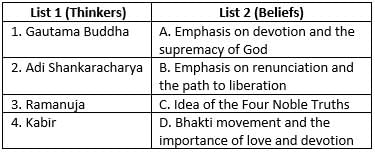History: CUET Mock Test - 2 - Humanities/Arts MCQ
30 Questions MCQ Test - History: CUET Mock Test - 2
Consider the following statements about the Indian National Army (INA).
1. The Indian prisoners of war released by Japan were recruited to the INA.
2. The idea of the INA was first conceived by Subhash Chandra Bose.
Which of the following statements is/are correct?
1. The Indian prisoners of war released by Japan were recruited to the INA.
2. The idea of the INA was first conceived by Subhash Chandra Bose.
Which of the following statements is/are correct?
Which of the following is not the outcome of the Swadeshi Movement?
In which of the following years did Mahatma Gandhi represent India in the Second Round Table Conference to discuss constitutional reform in India?
The terracotta models of plough have been found at which site?
The site of shortughai in Afganistan sources which material for craft production?
Arrange the following developments of 'Harrapan Archaeology' in chronological order:
(A) S.R. Rao begins excavations at Lothal.
(B) R.S. Bisht begins excavations at Dholviara.
(C) B.B. Lal excavates at Kalibangan.
(D) R.E.M. Wheeler excavates at Harappa.
(E) M.S. Vats begins excavations at Harappa.
Choose the correct answer from the options given below:
Identify the statements which are 'true' for Harrapan Civilisation.
(A) Animals were not domesticated in Harrapan culture.
(B) Evidence of ploughed field have been found at Kalibangan.
(C) Traces of canals have been found in Punjab and Sind.
(D) Water reservoirs have been found in Dholavira.
(E) Mohenjodaro has been identified as planned Urban Centre.
Choose the correct answer from the options given below:
Match List - I with List - II.

Choose the correct answer from the options given below:
What was the primary duty of the Brahmanas according to the Dharmashastras?
Which varna was responsible for trade and agriculture?
What does the term 'endogamy' refer to in the context of ancient Indian marriage rules?
Why were the Dharmashastras considered important for social order?
During which period were the Dharmasutras and Dharmashastras composed?
Mahatma Gandhi wanted to make ____ language as the national language.
What were the guilds of the merchants and craftsmen called?
According to Shastras, only __ could rule the country.





















